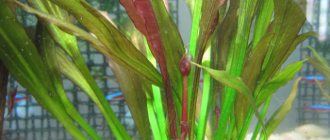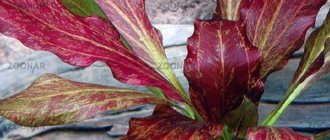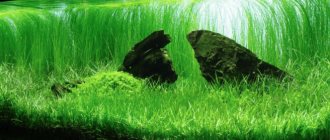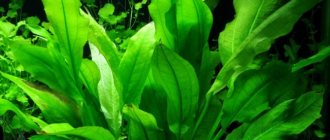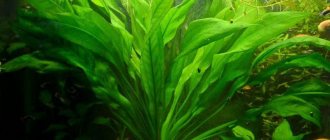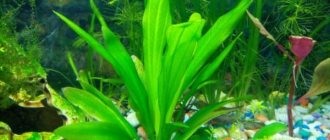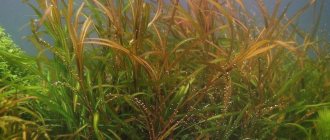Home › Aquarium plants › Catalog of aquarium plants ›
( 1 ratings, average: 5.00 out of 5)
Echinodorus augustifolia vesuvius is an amazing aquarium plant with attractive spiral-curling leaves. It got its name from the resemblance of the curly leaves to the wisps of smoke above the top of Mount Vesuvius. Outwardly, it looks a little like Vallisneria spiralis, but only at first glance. This is one of the varieties of the Echinodorus augustifolia species.
Description
The graceful, bright green plant of Echthinodorus Vesuvius grows from 7 to 15 cm, its narrow spiral-twisting leaves grow from a single rosette. The stem is short, the maximum width of the bush reaches 10 cm. Under favorable growing conditions, Echinodorus Vesuvius can sometimes bloom, producing a medium-sized arrow on which small white flowers are located.
Echinodorus tender
Famous aquarium plant. It has rich green leaves up to 5 mm wide. Does not have cuttings. Height is no more than 10 cm, growth continues throughout the year. Quite unpretentious.
ECHINODORUS TENDER: MAINTENANCE AND CARE
It needs to be grown on fine-grained soil (2 cm layer), which contains nutrients. The temperature range for the plant is wide - from 18˚C to 30˚C, but the best conditions are 25˚C (±1˚C). The optimal water hardness does not exceed 4˚, the medium is neutral or slightly alkaline. If the water is too soft, the leaves will begin to die.
The view requires good lighting. Fluorescent lamps from the LB series are used as artificial light. The power is selected depending on the volume of water. Daylight hours last about 10 hours.
Echinodorus soon develops 2-3 tendrils, on which daughter plants are formed. The mustache can be separated and transplanted to the desired location. They are accepted quickly.
Care
This type of Echinodorus is best planted in a large aquarium in front or in the middle of the tank. It will look beautiful both as a single bush and in a group planting. In a small aquarium, it is better to plant Echinodorus Vesuvius near the back wall, which will create a nice emerald green background. You need to know that failure to comply with any growing conditions will quickly lead to straightening of the famous spiral leaves of Echinodorus Vesuvius. They will lose their decorative effect and the plant will quickly turn into its ancestor Echinodorus angustifolia.
Echinodorus Vesuvius grows well at temperatures +220C - +280C, the optimal water hardness for its growth is dH 7 - 120, with the required acidity pH 6.5 - 7.5. The plant does not require additional filtration of aquarium water; it tolerates ordinary tap water, but not chlorinated and without nitrates. Echinodorus Vesuvius responds well to weekly replacement of 1/5 of the volume of aquarium water with a fresh portion.
To plant Echinodorus Vesuvius, you need to prepare the soil from coarse sand, mix it with granite chips up to 5-6 cm thick. A special role is played here by a certain siltation of the soil for the development of a full-fledged root system and its saturation with nutrients. Before planting, additional pieces of clay mixed with boiled peat, iron-containing compounds and charcoal must be placed under the roots.
Echinodorus Vesuvius will take root and take root more easily if its roots are slightly trimmed by 1-1.5 cm. The growth of this plant can be regulated by forming a bush and timely pruning. You need to cut it using either aquadesign scissors or regular ones.
Echinodorus Vesuvius loves light very much; an aquarium with this light-loving plant must be well lit, the intensity of bright light up to 0.5 - 1.0 W/l. If the plant does not have enough light, the leaves of Echinodorus Vesuvius will begin to straighten. It practically does not tolerate shading by tall plants or plants floating on the surface of the aquarium. Echinodorus Vesuvius will grow well in moist, warm paludarium conditions.
Conditions for keeping Echinodorus vesuvius
The maintenance of the plant is simple, but when temperature and light fluctuate, the leaves can become deformed and become straight. It then turns into a bush that resembles narrow-leaved Echinodorus.
Growing a plant does not take much effort and time. It is advisable to plant it in a medium-sized aquarium, where the bottom is already silted.
To prepare the soil you need to take a mixture of:
- sand;
- granite chips;
- pebbles.
To plant Echinodorus vesuvius, it is better to use a mixture of granite chips and fine sand.
The soil level at the bottom should be at least 5 cm. In order for Vesuvius to take root and adapt faster, you need to shorten the roots before planting. They should be buried 2-3 cm into the ground.
For optimal growth, it is worth considering such indicators as:
- temperature;
- acidity of water;
- rigidity.
The temperature should be +22...+27°C, hardness – 8-12 dH, and acidity – 6-7.5 pH. Tap water is suitable for Vesuvius, but it must first be cleaned of harmful impurities. This species does not need aeration or filtration.
Their presence and volume are determined by the needs of the fish living in the aquarium.
Echinodorus vesuvius prefers good lighting. For lighting, it is recommended to use lamps with a power of 0.5-0.7 W.
Periodically you need to apply additional fertilizers that contain iron. Additionally, it is necessary to saturate the water with carbon dioxide. Every week, 1/5 of the water needs to be renewed. If the Echinodorus stretches strongly upward, then you need to regularly trim the leaves with scissors for aquadesign.
Fertilizers
Echinodorus receives nutrition equally from both soil and water, and is very fond of feeding:
- once a month, apply liquid mineral fertilizers at the rate of 10-15 ml per 100 liters of water;
- Apply clay balls under the roots of the plant every three to six months.
Echinodorus Python
Echinodorus is a wonderful aquarium plant. Among the variety of species, there are those suitable for beginners and those that experienced aquarists can handle. The most common types are easy to care for and rarely get sick. If all maintenance recommendations are followed, Echinodorus will delight you with its healthy appearance, bright color and rapid growth.
Morphology
Hygrophila sinema has a smooth, elongated stem. The leaves under water are light green on top and silvery on the back. The shape of the plant's underwater leaves is very dependent on the degree of lighting. But this has practically no effect on their color. In fairly bright light, the leaves will be larger and more delicate. The type of leaves varies greatly.
They can be oval with small teeth along the edge, or they can be very cut or lacy. The leaves sometimes grow up to ten centimeters long and up to eight centimeters wide. On the stem, the leaves are located on the same line, and in all subsequent whorls they are oriented transversely with respect to the leaves of the previous whorl.
Sinema has a well-formed root system. If the upper part of the sinema reaches the surface of the water, then its leaves grow to their maximum size. Well-grown hygrophila of this genus with a well-developed stem produces vigorously growing shoots above the water, which, under favorable environmental conditions, produce pink inflorescences. They are located in the axils of the surface leaves.
Plant characteristics
Echinodorus is characterized by vegetative reproduction.
In nature, representatives of the genus grow in the water column, along the banks of reservoirs, and in wetlands.
Morphological description of the genus Echinodorus:
- The leaves form a dense or loose rosette. The veins are clearly visible on the outer side.
- The flowers are bisexual, 0.7-6 cm in diameter. The corolla consists of 3 petals, painted white, rarely yellow or pink.
- The multi-seeded fruit, 0.5-1 cm in size, breaks into pieces when ripe.
- The underground organs are represented by powerful rhizomes and adventitious roots.
All species of Echinodorus form above-water and underwater forms. They are able to lead a semi-submerged lifestyle, as well as survive on land in drying up water bodies. Plants are most often grown completely submerged. Echinodorus, which grows in the water column, does not bloom and reproduces vegetatively. In some species, vegetative buds are formed in the inflorescences, from which young shoots grow under favorable conditions in a humid environment.
The temperature favorable for echinodorus is +18…+22°C. In aquarium conditions they reproduce vegetatively - by division of rhizomes, suckers, leaf rosettes, and rarely - by seeds. Poor lighting and high acidity of water are unfavorable for growing.
Reproduction
Aquarium echinodorus reproduce in several ways:
- Seeds. Some selective and hybrid species reproduce exclusively this way. You can purchase seeds or wait for your plant to bloom. They form on flowers located above the surface of the water. Next, the seeds need to be sown in a separate bowl with sand covered with water at a temperature of 28°C. As soon as 3 leaves appear, you can transplant the plant into the aquarium.
- Vegetatively. Simple plant species reproduce in this way. They form many daughter shoots, from which new bushes develop. Find the outermost shoot, carefully cut it from the mother plant and transplant it into another aquarium.
- Dividing the roots. Remove the plant, remove spoiled leaves, wash well and trim the roots. Separate the roots so that there are 4-6 leaves on each side and cut in one motion using a utility knife or blade. There is no need to process the sections with anything.
Echinodorus osiris
Additional recommendations
In order for Echinodorus to fully develop and not be susceptible to a number of typical diseases, experienced aquarists advise paying attention to the following recommendations:
- Periodic replacement and filtration of water in the aquarium.
- Siphon the soil to avoid rotting of the root system.
- Periodic treatment of roots with birch charcoal.
- Additional lighting for 10 hours a day.
- Additional supply of oxygen and carbon dioxide.
- Fertilizing the soil with basal and root baits.
Following these simple tips will help protect the aquarium plant from putrefactive processes and various diseases, prolong its life and maintain its spectacular appearance.
To prevent the appearance of calcium deposits on the leaf plates, it is recommended to add snails or ancistrus to the aquarium.
Echinodorus coexist well with other aquarium plants that are approximately the same size as them. More spreading growths will shade the Echinodorus, which can negatively affect its growth and external characteristics. If you plant a plant with smaller algae, then the opposite situation is possible, especially if we are talking about light-loving crops.
General information
Echinodorus (lat. Echinodorus) are popular perennial aquarium plants. Due to their amazing adaptive abilities, they are unpretentious to water parameters, such as hardness, acid-base composition and light. Their sizes vary - from 1 cm to 1 m, depending on the specific species and conditions of detention. With the help of such simple plants it is quite easy to provide an amazing, eye-pleasing environment for your aquarium.
Most Echinodorus grow in swamps and on the banks of standing or flowing water bodies. There are only a few species of these aquatic plants that live in strong currents. Reservoirs can even be temporary, suitable for full plant life only during floods, but the rhizomes of Echinodorus allow them to remain viable in the ground even during short periods of drought. At this time, plants begin to intensively absorb and assimilate sunlight, forming inflorescences. This adaptation mechanism is most characteristic of subtropical and tropical species.
There is a connection with temperature fluctuations and high water. With periods of drought, water temperatures rise and flowering begins. While with high water the water temperature drops and the life cycle of plants slows down.
They require a minimum level of lighting - they can live both in sunny areas and in the shade.
Breeding rules
Reproduction of Echinodorus is carried out by lateral shoots of roots. The frequency of their appearance depends on the conditions of detention. In poor conditions, shoots should be expected no earlier than after 2-3 months.
To do this, cut off part of the plant with roots and plant it in another aquarium. When planting, it is recommended to remove the lower leaves. Over time, the plant will produce new leaves that will be adapted to the growing conditions. It is possible to grow Echinodorus from seeds, but this will be difficult.
Considering all these rules and recommendations for caring for Echinodorus, you can grow a beautiful and strong plant that will decorate your aquarium.
Bookmarks 0
Main varieties and their contents
The genus Echinodorus is distinguished by its species diversity and richness of hybrid and varietal forms. About 47 species are cultivated in aquariums.
A natural species with green, narrowly lanceolate leaves, E. Amazonicus is easily cultivated in aquariums. Grows well on poor soil, in water with a moderately alkaline or neutral reaction, at a temperature of 20... 25°C. To prevent the tips of the leaves from turning yellow in winter, the plant is illuminated continuously 12 hours a day.
Echinodorus amazonica is suitable for any aquarium.
Dancing feather
The hybrid E. "Tanzende Feuerfeder" prefers to grow on nutritious soil 5-8 cm thick. With a lack of iron salts in the water, the leaves turn pale, the color loses brightness and expressiveness.
If the maintenance conditions are met, large lance-shaped leaves with a variety of colors will grow on one bush - from burgundy to olive-green with red pigmentation.
In favorable conditions, Echinodorus dancing feather can bloom with large, delicate white flowers.
The rare aquarium plant E. horizontalis requires careful care. It is characterized by the difficulty of reproduction - the seeds do not ripen completely, and the seedlings develop slowly.
Grows well on clean sand in a neutral or slightly alkaline environment with intense light. The heart-shaped or ovate leaves are arranged horizontally, as they are connected to the petiole at an obtuse angle. Used by experienced plant growers to decorate underwater gardens.
To maintain this species, aquariums with a water temperature of 22 to 24 degrees are required.
A big bear
The hybrid E. "Grosser Baer" was obtained by crossing two species - E. barthii and E. parviflorus. Forms a bush with wavy, oval-shaped leaves of red-green color. Easily cultivated in neutral or moderately hard water on nutritious soil.
Echinodorus Great Bear is a plant with a rosette of leaves and a short stem.
Echinodorus schlutera
E. "Schlueteri" quickly reproduces by daughter plants. Grows well in neutral or slightly alkaline water with a high CO₂ content. A bush with picturesque green leaves decorated with red-brown specks is used to decorate the foreground or middle ground.
Schlüter's Echinodorus is not found anywhere in nature, but is unpretentious to external conditions.
Argentinian
The bright green E. Argentinensis bush grows up to 80 cm and is only suitable for large aquariums. Tolerates cool water and moderately acidic environments. Slowly propagates by daughter plants formed on massive rhizomes.
Reproduction of Echinodorus Argentinean in an aquarium is extremely difficult, since daughter plants are very rarely formed on the rhizomes.
Echinodorus ocelot
The hybrid was obtained by crossing E. barthii with E. schluteri “Leopard”. The plant is unpretentious - it grows both in light and in partial shade. Withstands a temperature range from 18 to 30°C, water hardness – 5-15°dH.
We suggest you read: How to choose a shorthaired pointer puppy for hunting
There are 3 main forms bred in culture:
- Gold (golden) - yellow-brown oval leaves with brown pigmentation.
- Green – bright green leaves with ruffled edges and dark streaks.
- Red – green leaves with a red tint and dark specks.
The plant is medium ground, reaches a height of 40 cm.
St. Elmo's Fire
E. "Sankt Elmsfeuer" grows in water of any hardness on nutritious soil. Young leaves are wine red, old leaves are olive green. It is grown in aquariums with a height of 50 cm as a main plant.
Echinodorus "St. Elmo's Fire" reproduces by arrows, each of which carries up to 10 shoots.
Echinodorus red
The red varieties include the following varieties of Echinodorus: “Bartha”, “Rose”, “Ruby”, “Florence”, “Ocelot”, “Aflame”, “Kleiner Ber”, “Indian Red”, “Jungelstar”. The bushes acquire a crimson color when the water temperature does not exceed 12...15°C. At 22...25°C only 1-3 young leaves retain their red color. The food source is liquid fertilizers dissolved in water.
Echinodoru Aflame is a hybrid of unknown origin. Its ancestors are South American plants.
Emerald Echinodorus was bred by breeder Igor Filippov. Young leaves are translucent, with a white tint. Propagated by root daughter plants.
Echinodorus supreme gardener is capricious, so only experienced aquarists can reproduce it at home.
Echinodorus black
The species E. portoalegrensis with black-green leaves is a medium-ground plant. Due to the fact that the bush is not multi-leaved, the plants behind it are clearly visible. To highlight the decorative nature of portoalegrensis, light green plants are planted in the background - echinodorus bleheri, E. maior, E. berteroi, E. intermedius, E. sellovianus.
If you plant bright green plants against the background of black echinodorus, this will emphasize its beauty.
The hybrid E. parviflorus "tropica" produces a compact bush with lanceolate, bright green leaves with ruffled edges. The plant, easy to cultivate, requires regular fertilization and additional carbon dioxide.
Echinodorus parviflora tropica forms a compact but lush rosette that will become a real decoration of the aquarium garden.
Echinodorus vesuvius
A rare variety of E. "Vesuvius" was bred at the Oriental Aquarium Plants nursery in Singapore based on Echinodorus angustifolius. Its delicate spiral-twisted narrow leaves of bright green color are collected in a rosette and create the appearance of a beautiful bouquet.
Beginning aquarists will definitely like the unpretentious, but very beautiful and unusual Echinodorus vesuvius.
Devil's eye
E. 'Devil's Eye' features smooth green leaves edged with dark brown. On the outside, the leaf blades, boat-shaped with a rounded nose, are covered with a dark brown mesh. On young leaves, 5 bright red veins clearly appear. As you age, pigmentation weakens.
The devil's eye loves bright lighting.
The species E. latifolius is undemanding in terms of water composition and soil nutrition. It develops well in winter, with short days and poor lighting. It quickly reproduces by basal shoots at 25... 30° C. It is used to decorate the foreground and middle plans of the aquarium. In intense light it forms a compact bush with dark green leaves 5-7 cm long.
Under good conditions and the required amount of nutrients, Echinodorus latifolius grows quickly and forms a thick carpet.
Bertera
Natural Echinodorus E. berteroi is characterized by unstable leaf shape. One bush simultaneously contains ribbon-shaped, arrow-shaped with a sharp end, heart-shaped with a pointed or rounded edge, and narrow elliptical leaf plates.
We invite you to familiarize yourself with the Breeds of the largest dogs in the world
A pattern of veins of a lighter tone decorates their outer surface. Light green young leaf blades take on a pink tint in bright light. With long daylight hours (more than 12 hours), floating leaves appear, which disappear when the light decreases.
Echinodorus Bertera is not demanding and adapts well to a wide range of temperatures.
In an aquarium, E. angustifolius forms a bush with green leaves 0.5-0.8 cm wide and 40-50 cm long. In good lighting, a dwarf form with narrow leaf blades - 0.2-0.3 cm is formed. Easily propagated by young plants , which are formed on root shoots. In shaded aquariums it forms tall growths that reach the surface of the water. Favorable conditions for this species are a slightly acidic or neutral environment and a water temperature of 20... 22°C.
Echinodorus angustifolia prefers natural light.
A large group of hybrids was bred by Igor Filippov. Collection of Echinodorus from a Chelyabinsk amateur breeder:
- Green - “Green-pregreen”, “Green Firefly”, “Supreme Landscaper”, “Your Grace”, “Thundering”, “Acryptodorus”, “Emerald”, “Merry Family”.
- Spotted - “My Precious”, “Grand Vizier”, “Black Reggae”, “Road of the Bark Beetles”, “Inquisitor”.
- Brown - “Sinusoid”, “Pioneers on the March”, “Dear Leonid Ilyich”, “Comandante Cippolino”, “Ruthless”, “Sensible”, “Disobedient Oppressor”.
- Red - “Maghribinets”, “Cherry Hunter”, “Bloody Tourists”, “Michurinets Filippov”, “Lisbon”, “Good Night”.
- Conventionally yellow - “The Kindness of the Sandman”, “Sunny Breadwinner”.
Unpretentious, brightly colored plants are popular among aquarists. The author gives each copy an original name.
One of the specimens of Echinodorus by Igor Filippov.
Species diversity of Echinodorus, their features
Without exception, all aquarium lovers are engaged in growing special plants. There are many of them. A plant such as Echinodorus is not the least popular due to its ease of cultivation, maintenance and ability to adapt to existing temperature conditions.
Maintaining the plant is not at all difficult, if you do not take into account some particularly heat-loving species, which in cold and soft water begin to wither and lose leaves.
The plant prefers and develops better in clean water, without direct rays of light. Installation of a filter and aeration device is required. Once a week it is necessary to replace the water with fresh water and saturate it with additional carbon dioxide. Some types of shrubs respond well to fertilization with sludge or fertilizing with iron, but you should not overdo it with organic and chemical fertilizers. They can only be used if the bush grows too much.
